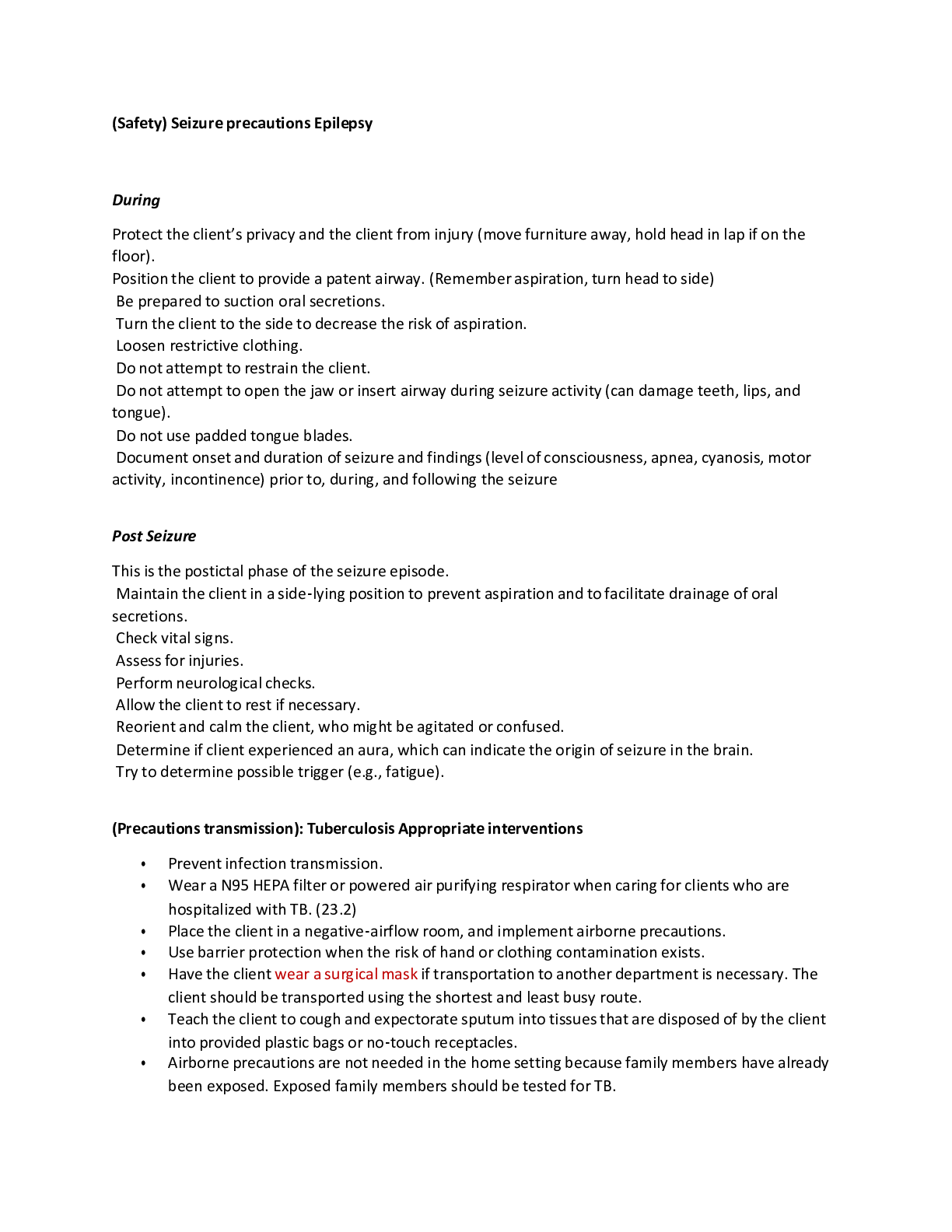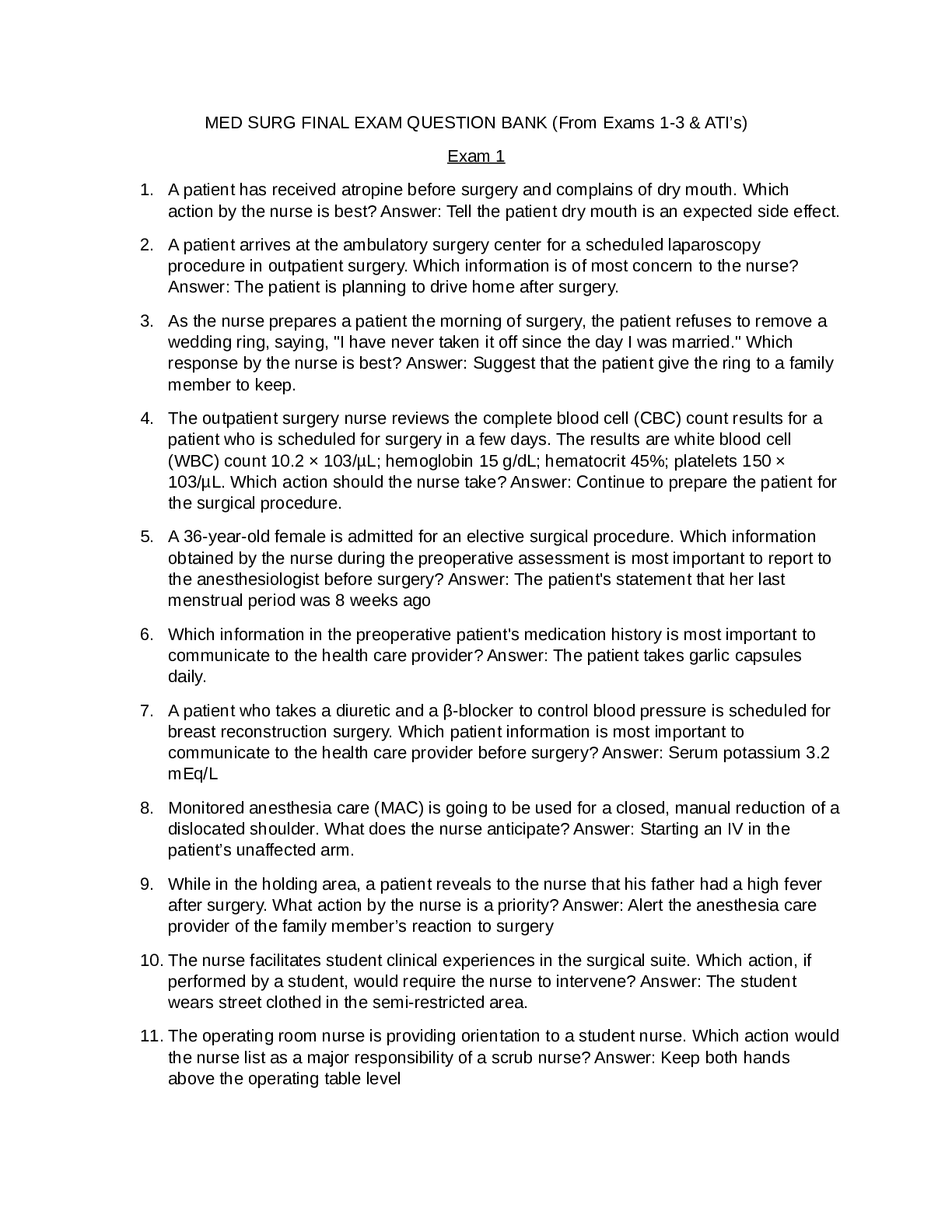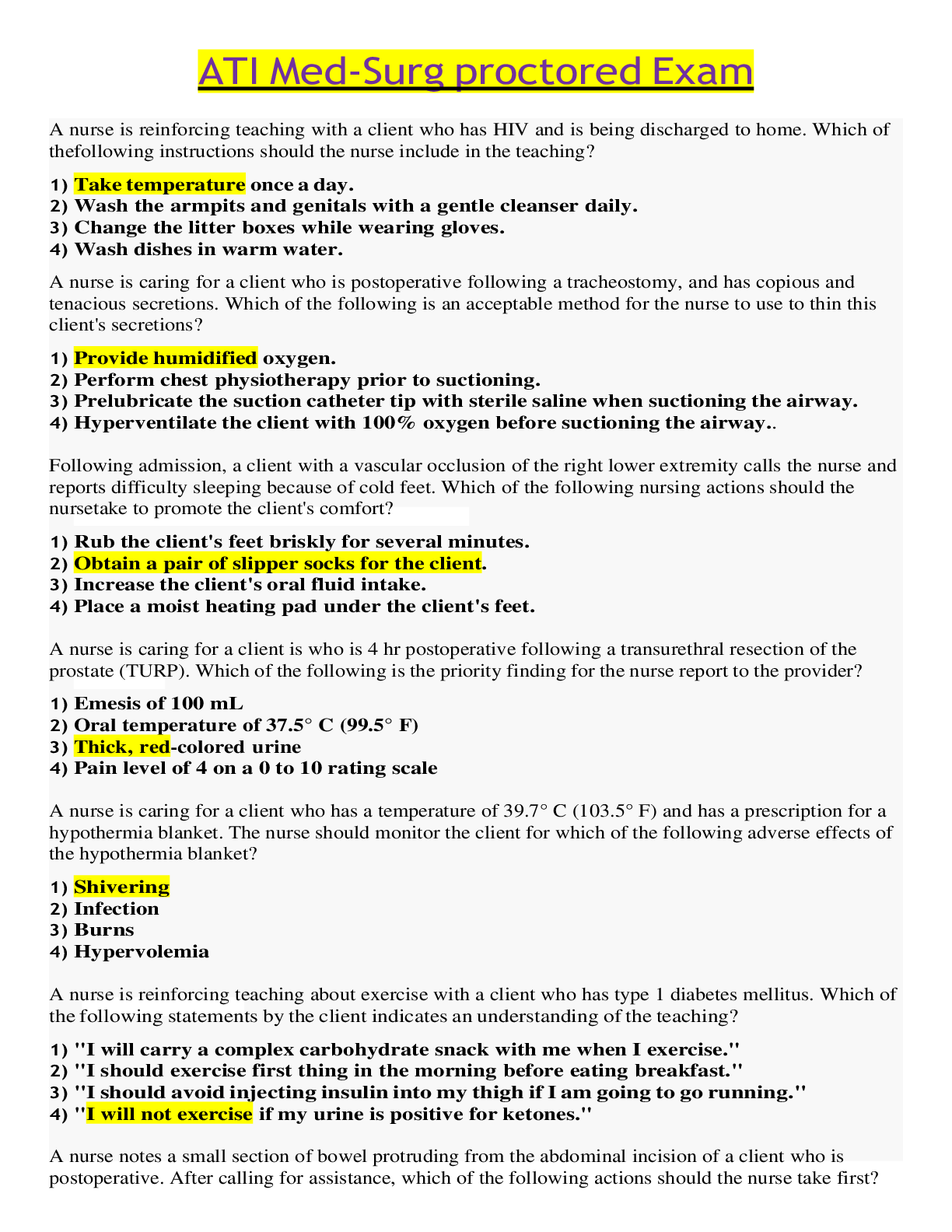*NURSING > ATI MEDICAL SURGICAL > ATI Med Surg Critical Points great hints (All)
ATI Med Surg Critical Points great hints
Document Content and Description Below
ATI Med Surg Critical Points ATI Med Surg Critical Points Topics to Review Safety and Infection Control (4 items) Accident/Error/Injury Prevention (1 item) Seizures and Epilepsy: Implementing P... recautions (RN QSEN - Safety, Active Learning Template - System Disorder, RM AMS RN 10.0 Chp 6) • Seizures are abrupt, normal, excessive, and uncontrolled electrical discharge of neurons within the brain that can cause alterations in the level of consciousness and changes in motor and sensory ability and/or behavior. Epilepsy is the term used to define chronic recurring abnormal brain electrical activity resulting in 2 or more seizures. • Precautions include knowing the risk factors related to seizures and epilepsy; genetic predisposition, acute febrile state, head trauma, cerebral edema, abrupt cessation of antiepileptic drugs. • There are triggering factors of seizures and epilepsy; increased physical activities, excessive stress, hyperventilation, alcohol, caffeine, flashing lights, substance abuse, aerosols, stress, and fatigue. It is important for nurses to know these factors in an order to implement precautions. Home Safety (1 item) Musculoskeletal Trauma: Discharge Teaching About an External Fixation Device (RN QSEN - Safety, Active Learning Template - Basic Concept, RM AMS RN 10.0 Chp 71) • External fixation involves fracture immobilization using percutaneous pins and wires that are attached to a rigid external frame. • For care of the device: clean the external fixation pins one to two times each day to remove exudate that can harbor bacteria, using a separate cotton swab on each pin will decrease the risk of cross‑contamination, which could cause pin site infection. • Advise the client that they should report redness, heat, and drainage at the pin sites, which can indicate an infection that can lead to osteomyelitis. Discuss clothing and other materials that can be used to cover the device. If activity is restricted, advise the client to perform deep breathing and leg exercises and other techniques to prevent complications to immobilization, such as pneumonia or thrombus formation. Standard Precautions/Transmission-Based Precautions/Surgical Asepsis (2 items) Infection Control: Teaching About Isolation Precautions (RN QSEN - Safety, Active Learning Template - Basic Concept, RM FUND RN 9.0 Ch 11) • Infection occurs when the presence of a pathogen leads to a chain of events, all components of chain must be present and intact for the infection to occur. Nurses use infection control practices to break the chain and thus stop the spread of infection. • Isolation guidelines are a group of actions that include hand hygiene and the use of barrier precautions which intend to reduce the transmission of infectious organisms. Precautions apply to every client, regardless of the dx and implementation of them must occur whenever there is anticipation of coming into contact with infectious material. • Clients in isolation are at high risk for depression and lonliness, assist client and their family to understand the reason for isolation and provide sensory simulation. Health Promotion and Maintenance (2 items) Health Promotion/Disease Prevention (1 item) Health, Wellness, and Illness: Identifying Risk Factors for Atherosclerosis (Active Learning Template - System Disorder, RM AMS RN 10.0 Chp 1) • Atherosclerosis is caused by gradual thickening of the intima and media of the arteries, it results in the progressive narrowing of the lumen. • Plaques may form on the walls of the arteries, making them rough and fragile. • Familial predisposition, High blood pressure, smoking, diabetes, obesity, unhealthy cholesterol levels are some major risk factors for atherosclerosis. Basic Care and Comfort (6 items) Elimination (4 items) Postoperative Nursing Care: Urinary Retention (Active Learning Template - System Disorder, RM AMS RN 10.0 Chp 96) • Monitor fluid and electrolyte balance following surgery. Monitoring can help determine if there is an issue of urinary retention. • Nursing care related to input and output should include: Palpate bladder for distention. Monitor urinary catheters for patency. Observe color, consistency, odor, and amount of urine. Urine output less than 30 mL/hr can indicate hypovolemia. • Urine output of at least 30 ml/hr is part of the criteria for discharge from PACU. Urinary Elimination: Teaching a Client to Manage Stress Incontinence (RN QSEN - Patient-centered Care, Active Learning Template - System Disorder, RM FUND RN 9.0 Ch 44) • Stress incontinence is loss of small amounts of urine from increased abdominal pressure without bladder muscle contraction with laughing, sneezing, or lifting. • A therapeutic procedure related to the treatment of stress incontinence is a bladder-retraining program. Urinary bladder retraining increases the bladders ability to hold urine and clients’ ability to suppress urination. • Nurses can teach the client how to perform Kegel exercises: tighten pelvic muscles for a count of 10, relax slowly for a count of 10 and repeat in sequences of 15 in the lying-down, sitting and standing positions. Mobility/Immobility (1 item) Mobility and Immobility: Climbing Stairs With Crutches (RN QSEN - Safety , Active Learning Template - Nursing Skill, RM FUND RN 9.0 Ch 40) • Maintain or regain body alignment and stability, decrease skin and musculoskeletal system changes, achieve full or optimal ROM, and prevent contractures. • Nurse should assist the client with ambulation. Use assistive devices such as gait belts, walkers, canes, or crutches as needed. • Crutch instructions: do not alter crutches after fitting, follow the prescribed crutch gait, support body weight at the hand grips with elbows flexed at 30 degrees, and position the crutches on the unaffected side when sitting or rising from a chair. Non-Pharmacological Comfort Interventions (1 item) Vitamins, Minerals, and Supplements: Medication Interaction With Feverfew (RN QSEN - Safety , Active Learning Template - Medication, RM Pharm RN 7.0 Chp 30) • Feverfew is used to decrease the frequency of migraine headaches, but it has not been proven to relieve an existing migraine headache. • Feverfew can cause increased risk of bleeding in clients taking NSAIDs, heparin, and warfarin. Discontinue 2 weeks before elective surgery. • Question clients about concurrent use of NSAIDs, heparin, and warfarin. Pharmacological and Parenteral Therapies (23 items) Adverse Effects/Contraindications/Side Effects/Interactions (6 items) Medications Affecting Blood Pressure: Adverse Effects of Enalapril (RN QSEN - Safety , Active Learning Template -Medication, RM Pharm RN 7.0 Chp 20) • Blood pressure is controlled in a variety of ways with many meds that are used alone or in combination. • Enalapril is a medication for hypertensive crisis. It is an ACE inhibitor. • Enalapril should be administered slowly because rapid administration will cause blood pressure to go down rapidly. Blood and Blood Products (2 items) Blood and Blood Product Transfusions: Steps in the Administration Process (RN QSEN - Safety , Active Learning Template - Nursing Sk. [Show More]
Last updated: 2 years ago
Preview 1 out of 16 pages
.png)
Buy this document to get the full access instantly
Instant Download Access after purchase
Buy NowInstant download
We Accept:

Reviews( 0 )
$14.00
Can't find what you want? Try our AI powered Search
Document information
Connected school, study & course
About the document
Uploaded On
Jan 09, 2021
Number of pages
16
Written in
Additional information
This document has been written for:
Uploaded
Jan 09, 2021
Downloads
0
Views
117






 (1).png)






